
Articles on the Anthropocene
In-depth articles on the Anthropocene
Should we rely on the forest carbon sink to limit climate change?
Why relying on forests for climate mitigation is neither relevant nor responsible
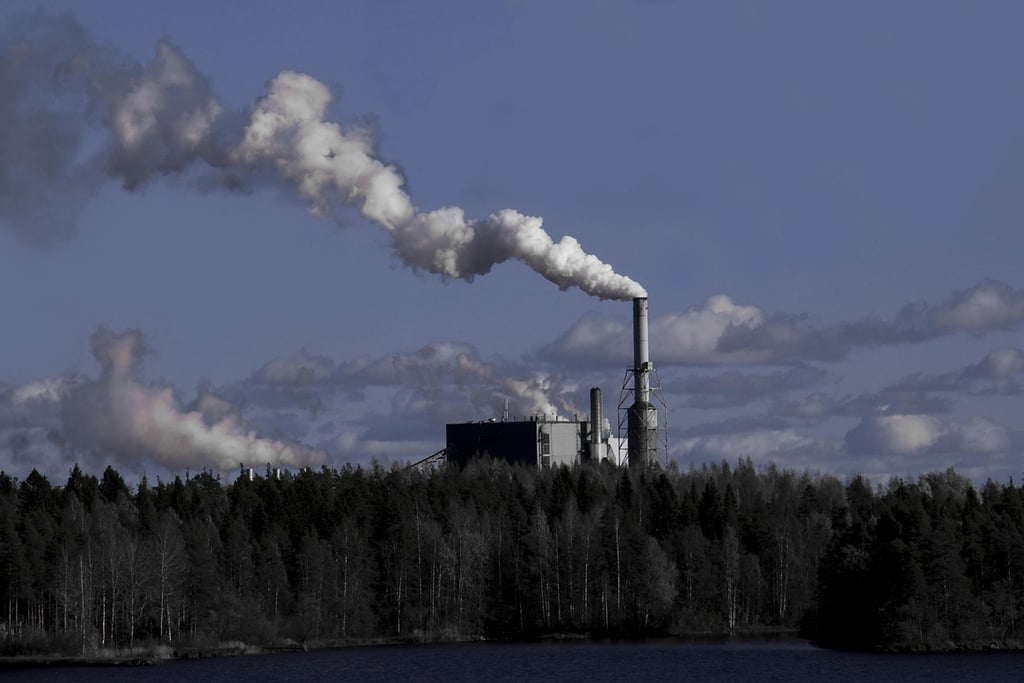

Does relying on forests to limit human-induced climate change make sense? Source: Image by alinajyrkinen from Pixabay, https://pixabay.com/fr/photos/pollution-usine-bleu-2058429/.
For decades, forests have acted as a powerful carbon sink, significantly mitigating the increase of the greenhouse effect [1, 2, 3]. The thermo-industrial civilization, attempting to limit climate change caused by its development model—but without disrupting it in the slightest (a rather tricky challenge!)—has naturally placed great hope in the continued existence of the “forest carbon sink.” But is this really reasonable—or even feasible—considering that the carbon sink is merely a transitory phase in forest dynamics, and not something meant to last forever?
A longstanding forest carbon sink in France and worldwide
Global forests store approximately 870 gigatonnes (GtC) of carbon [3], distributed as follows: 45% in soil (up to one meter deep), 43% in living biomass (above and below ground), 8% in dead wood, and 4% in litter. This is comparable to the carbon stock of the atmosphere, estimated at 890 GtC [1]. Forests continuously exchange carbon with the atmosphere, making them a critical component of Earth’s carbon budget.
As explained in the previous article, a forest becomes a carbon sink when it absorbs more carbon than it emits—its carbon stock increases over time. Globally, forests have acted as large, stable sinks over the last two decades [2, 3], helping slow climate change.
Between 2014 and 2023, forests absorbed an average of 3.5 GtC (12.8 gigatonnes de CO2*, GtCO2) annually [3], or around 30% of human emissions, estimated at 10.8 GtC per year (39.5 GtCO2 per year) [1]. Yet deforestation severely weakens this effect, generating ~2.2 GtC (8 GtCO2) annually, canceling nearly two-thirds of the net uptake [3].
Exceptionally favorable conditions…
Despite deforestation, forests have acted as a powerful and sustainable carbon sink over recent decades. As we have seen, however, the carbon sink is not a “function” of forests, but a transitional phase. This raises two questions: What explains the “forest carbon sink” observed globally in recent decades? And will this phenomenon continue in the future?
With regard to the first question, forests have in fact benefited from quite exceptional conditions in recent times, with two main causes explaining the overall carbon sink:
Cause no. 1: The forest recolonization observed for several decades in many so-called “developed” countries, particularly in Europe and Asia (Figure 1). This process, described by Mather as a “forest transition” [4], is largely linked to the intensification of agriculture. The latter has generated a vast movement of agricultural abandonment, with freed-up farmland eventually being recolonized by forest (when not concreted over for urbanization). In France, for example, since the minimum forest cover was reached in the early 19th century, the forest area has doubled, mainly as a result of agricultural abandonment, which in turn depends on the intensification of agriculture made possible by the massive use of fossil fuels (for mechanization, fertilizers, pesticides, etc.).


Figure 1: Annual change in forest area by world region (top) and country (bottom). While forests are losing surface area massively in South America and Africa, mainly due to deforestation, they are expanding in other regions of the world, for example in Europe (France, Spain, Germany, etc.) and Asia (China, India, Kazakhstan, etc.). Top image source: Modified from FAO (https://openknowledge.fao.org/handle/20.500.14283/ca8753en) [5]; Bottom image source: Modified from Our World In Data (https://ourworldindata.org/forests-and-deforestation) [6].
A) Change in forest area by continent in 2000-2010 and 2010-2020 (millions of hectares per year)

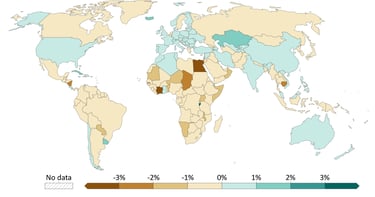
B) Change in forest area by country in 2020 (% per year)
Cause no. 2: The stimulation of vegetation by the fertilizing effect of CO₂; the rise in atmospheric CO₂ content had a fertilizing effect (CO₂ constituting the raw material for photosynthesis) that stimulated vegetation growth [7], contributing to a “greening” of the Earth on a global scale [8, 9] (Figure 2).
Other explanatory factors for the forest sink include fertilization through increased nitrogen deposition, and the positive effects of climate change, such as the lengthening of the growing season (plants tend to bud earlier in spring, and continue growing later into autumn) [9].
... but worrying signs
While forests have benefited from particularly favourable conditions over the last few decades (notwithstanding the major black mark of deforestation), several signals show that we may have reached a tipping point. In recent years, the negative effects of extreme climatic events (successive droughts) have been observed on a global scale [11], but also particularly in Europe [12] (Figure 3).
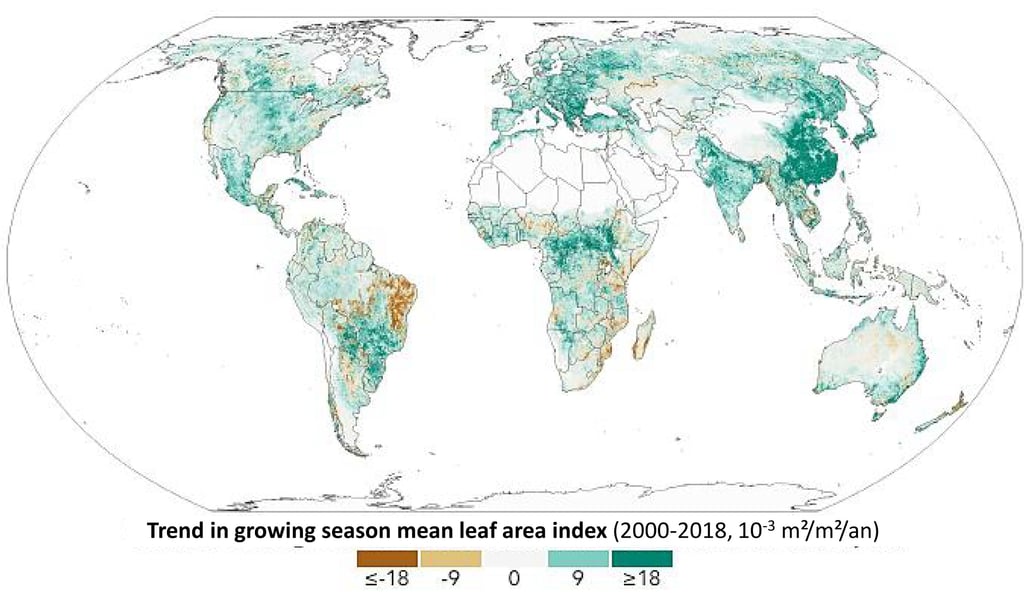

Figure 2: Map of the “greening of the Earth”. The map shows the areas of the planet where “greenness” has increased (green) or decreased (brown) between 2000 and 2018. More specifically, it illustrates the evolution of the leaf area index - the amount of leaf area in relation to the soil surface - during the growing season. This index is calculated using sensors aboard NASA's Terra and Aqua satellites. White zones correspond to land without vegetation (deserts, urbanized areas, ice or water, etc.). Generally speaking, there is a clear trend towards the “greening” of the Earth, i.e. the quantity of leaves per unit area is tending to increase. Image source: NASA (https://earthobservatory.nasa.gov/images/146296/global-green-up-slows-warming) [10].
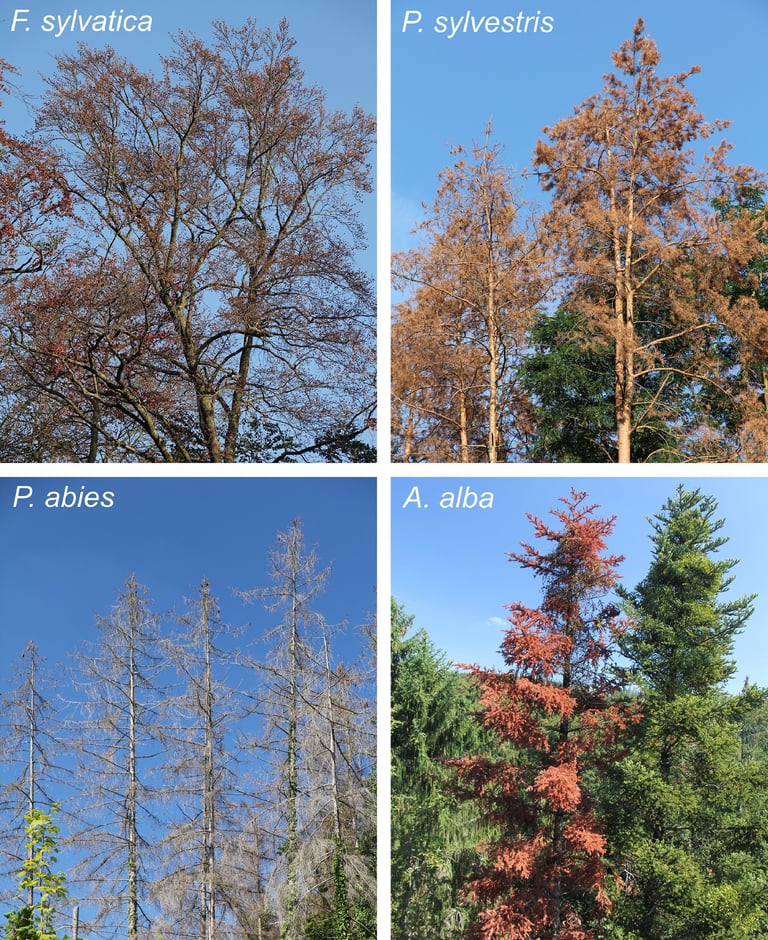

Figure 3: Illustration of forest tree mortality in Europe. Intense and repeated droughts since 2016 have led to significant waves of forest dieback in Europe for many tree species, such as beech (top left), Scots pine (top right), Norway spruce (bottom left) and silver fir (bottom right). Image source: Schuldt et al. (2020), https://www.sciencedirect.com/science/article/pii/S1439179120300414 [12].
Generally speaking, observations reveal a deterioration in tree health. In France, for example, forest tree mortality has doubled in just a few years [13] (Figure 4). Trees in poorer health mean that they grow less well and die more, which ultimately leads to a reduction in carbon sequestration by the forest.


Figure 4: Tree mortality in France's forests since 2009. While it was estimated that around 80 million trees died each year until 2016, mortality has doubled in just a few years, reaching almost 150 million dead trees by 2023. Data source: Inventaire Forestier National [13].
In France, for example, the “carbon sink” effect of forests has halved in the space of a decade [14]. France's forests (excluding soils) are estimated to have absorbed between 15 and 20 million tonnes of carbon (55 to 75 million tonnes of CO2) per year in recent years, equivalent to around 15% of French emissions [15]. But while the forest carbon sink amounted to around 16 million tonnes of carbon (60 million tonnes of CO2) in 2010, it would have fallen to 8 million tonnes of carbon (30 million tonnes of CO2) in 2020 [14].
On a global level, in addition to the deterioration in tree health, fires of exceptional size (megafires), timing and duration are now regularly observed around the world, for example recently in Canada [16], Bolivia [17], Russia [18], Australia [19] and the USA [20].
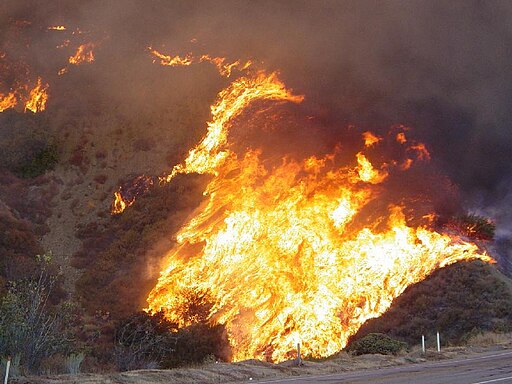

Figure 5: Megafire in California (September 12, 2007). Source: California Department of Forestry photo by Bill Peters, Public domain, via Wikimedia Commons. https://commons.wikimedia.org/wiki/File:Day-fire-cdf-01.jpg ; https://upload.wikimedia.org/wikipedia/commons/b/bc/Day-fire-cdf-01.jpg.
Last but not least, the spectacular expansion of forest areas over the last few decades in some countries, notably France, has largely been at the expense of agricultural land. It therefore seems clear that this dynamic cannot continue indefinitely, unless we compromise our ability to feed ourselves by prolonging agricultural decline.
Should we count on a continuation of the forest carbon sink?
Let's now return to the second question raised above: will the forest carbon sink continue in the future? Two points stand out from the trends outlined above:
Forests have absorbed around 30% of our CO2 emissions over the last few decades, an effect made possible by extraordinarily favourable conditions, combining strong forest expansion in certain regions and a general stimulation of plant growth by rising atmospheric CO2 levels.
However, there are several signs of a major change underway, with the negative effects of climate change increasingly affecting the health of forests and, by extension, their ability to absorb carbon.
Global forest dynamics may therefore be at a turning point. Just as we have become accustomed to economic growth, believing it to be an unstoppable and normal dynamic, so we have become accustomed to the “forest as carbon sink”. Unfortunately, we may have to change our habits and stop relying on the forest to absorb all our waste.
Once we accept that the forest has done us an immense “service” - in spite of itself, I don't believe in the vision of the forest designed to serve us - by absorbing a significant proportion of our emissions, but that this effect is likely to decline or even cease in the short term, we can adopt one of two attitudes:
“I can't get enough”: it's vital to maintain and even strengthen the forest carbon sink, as our climate change mitigation policies depend on it (because we can't/won't cut our emissions too much either).
“I'm facing up to my responsibilities”: thanks to the forest, which has done us a great service, but maybe it's time to stop relying on others and embark on a real global policy to reduce emissions (who's the smart aleck who said “décroissance” at the back of the class? It's out there!)
Of course, the analogy with economic growth remains apt, and it's the “I can't get enough” attitude that prevails today, with its solemn calls to “act” to “adapt forests to climate change” and to foster “forest resilience” so that they continue to provide us with many “services”, but above all without ever calling into question our lifestyles and economic principles.
Long live the forest and long live the trees!
If betting on the continuation of the forest carbon sink seems like an unreasonable and irresponsible attitude from a civilization mired (radicalized?) in its ideological principles, it is nevertheless obvious that urgent measures must be taken in favor of forests:
Stopping deforestation is the ultimate priority, given the catastrophic impact of the phenomenon on greenhouse gas emissions and, more generally, on the planet's habitability;
Encourage the return of trees (possibly by planting, but also and above all by natural regeneration) wherever possible and relevant**: for example in towns, in fields by encouraging the return of hedgerows and “scattered” trees, in individual gardens***, in communal parks, etc.
Once again, the challenge of “taking care of forests ”**** obviously goes beyond carbon sequestration: to stay with the theme of climate change, the presence of trees ensures a refreshing atmosphere, but beyond that, a forest, or more generally a wooded environment, is often above all a place teeming with life, populated by multiple species linked by interdependencies, a place of existence for many human communities (“indigenous peoples”), a “recreational” space shared by many “users” (members of the thermo-industrial civilization, who think very much in terms of entertainment and use), or a simply beautiful and serene place, conducive to calm and contemplation.
Notes
*This is linked to the respective molar masses of the carbon “C” and oxygen “O” atoms linked in a CO2 molecule; the molar mass of C is 12g/mol, that of O 16 g/mol; a CO2 molecule therefore represents 44 g/mol (12 + 2 * 16) ; to convert a mass of CO₂ into a carbon equivalent, we therefore multiply by 12/44 ≈ 0.27, which corresponds to the ratio between the molar masses of carbon (12 g/mol) and CO₂ (44 g/mol); conversely, to convert carbon into a CO₂ equivalent, we multiply by 44/12 ≈ 3.67.
**This means not just anywhere, either: open environments such as grasslands and savannahs are fundamental to the life of many species.
***I'm flabbergasted by the trend towards mineralization around the perimeter of recent homes: stony terraces, swimming pools and perimeter walls seem to be the new ideals of a generation visibly struck by a phobia or detestation of the organic.
****That doesn’t necessarily mean rushing to take action; sometimes, caring for forests simply means leaving them be.
References
[1] P. Friedlingstein et al., « Global Carbon Budget 2024 », Earth System Science Data, vol. 17, no 3, p. 965‑1039, 2025. https://doi.org/10.5194/essd-17-965-2025
[2] Y. Pan et al., « A large and persistent carbon sink in the world’s forests », Science, vol. 333, no 6045, p. 988‑993, 2011. https://doi.org/10.1126/science.1201609
[3] Y. Pan et al., « The enduring world forest carbon sink », Nature, vol. 631, no 8021, p. 563‑569, 2024. https://doi.org/10.1038/s41586-024-07602-x
[4] A. S. Mather, « The forest transition », Area, p. 367‑379, 1992. https://www.jstor.org/stable/20003181
[5] FAO, « Global Forest Resources Assessment 2020: Main report. Rome, Italy », 2020. https://doi.org/10.4060/ca8753en
[6] H. Ritchie, F. Spooner, et M. Roser, « Forests and Deforestation », Our World in Data, 2021. https://ourworldindata.org/forests-and-deforestation
[7] E. C. Davis, B. Sohngen, et D. J. Lewis, « The effect of carbon fertilization on naturally regenerated and planted US forests », Nat Commun, vol. 13, no 1, Art. no 1, sept. 2022. https://doi.org/10.1038/s41467-022-33196-x
[8] S. Piao et al., « Characteristics, drivers and feedbacks of global greening », Nat Rev Earth Environ, vol. 1, no 1, p. 14‑27, 2020. https://doi.org/10.1038/s43017-019-0001-x
[9] Z. Zhu et al., « Greening of the Earth and its drivers », Nature Clim Change, vol. 6, no 8, p. 791‑795, 2016. https://doi.org/10.1038/nclimate3004
[10] NASA, « Global Green Up Slows Warming », NASA Earth Observatory. Consulté le: 16 juillet 2025. https://earthobservatory.nasa.gov/images/146296/global-green-up-slows-warming
[11] W. M. Hammond et al., « Global field observations of tree die-off reveal hotter-drought fingerprint for Earth’s forests », Nat Commun, vol. 13, no 1, p. 1761, avr. 2022. https://doi.org/10.1038/s41467-022-29289-2
[12] B. Schuldt et al., « A first assessment of the impact of the extreme 2018 summer drought on Central European forests », Basic and Applied Ecology, vol. 45, p. 86‑103, juin 2020. https://doi.org/10.1016/j.baae.2020.04.003
[13] IGN, « Mémento, édition 2024 », 2024. https://inventaire-forestier.ign.fr/IMG/pdf/memento_2024.pdf
[14] C. Deleuze et al., « Le carbone forestier : un équilibre à trouver entre la préservation des stocks et le maintien d’une pompe à carbone », Annales des Mines, vol. 115, p. 14‑21, 2024. https://www.annales.org/re/2024/re115/2024-07-04.pdf
[15] Centre Interprofessionnel Technique d’Etudes de la Pollution Atmosphérique (CITEPA), « Rapport National d’Inventaire pour la France au titre de la Convention cadre des Nations Unies sur les Changements Climatiques », 2023. https://foret.ign.fr/api-obs/upload/CCNUCC_france_2023.pdf
[16] Les Décodeurs, « Mégafeux au Canada : 13,7 millions d’hectares de forêt brûlés, deux fois plus que l’année record de 1989 », Le Monde, 2023. https://www.lemonde.fr/les-decodeurs/article/2023/08/17/megafeux-au-canada-13-7-millions-d-hectares-de-foret-brules-deux-fois-plus-que-l-annee-record-de-1989_6185725_4355770.html
[17] M. Esnault, « En Amazonie bolivienne, les autorités dépassées par des feux incontrôlables », Reporterre, 2024. https://reporterre.net/En-Amazonie-bolivienne-rien-ne-peut-arreter-les-megafeux
[18] Courrier international, « En Sibérie, les mégafeux ravagent une surface “plus grande que le Luxembourg” », Courrier international. 2022. https://www.courrierinternational.com/article/russie-en-siberie-les-megafeux-ravagent-une-surface-plus-grande-que-le-luxembourg
[19] B. Leclère, « Australie - « Le continent brûlé » face aux incendies de forêts : l’Australie est-elle réellement un « lucky country » ? | CNES », Le CNES, 2020. https://cnes.fr/geoimage/australie-continent-brule-face-aux-incendies-de-forets-laustralie-reellement-un-lucky-country
[20] Reporterre, « Mégafeux en Californie : l’état d’urgence décrété à Los Angeles », Reporterre, 2024. https://reporterre.net/Megafeux-en-Californie-l-etat-d-urgence-decrete-a-Los-Angeles
Conclusion
Over the last few decades, the world's forests have acted as a powerful “carbon sink”, absorbing around 30% of our CO2 emissions and helping to mitigate climate change.
Despite deforestation cancelling out many of the effects, the forest carbon sink has been made possible by a combination of several favourable factors, including forest recolonization in certain regions of the world and the overall fertilizing effect of rising CO2 levels in the atmosphere.
However, even in an exceptionally favourable climate, forests have only been able to absorb a fraction of our emissions. Above all, this “carbon sink” effect, by its very nature transitory, is reaching its limits, with warning signs accumulating: declining forest health, slower growth and increased tree mortality, megafires... are the first stigmata of the negative effects of climate change, which are set to worsen.
Faced with this trend, it would be illusory - even irresponsible - to continue to rely on forests as a sustainable solution to our excesses. The real answer lies in a profound rethinking of our economic and development models. It's a conclusion we're desperate to reach if we take even the slightest interest in the root causes and scale of today's ecological catastrophe...
Henri Cuny
